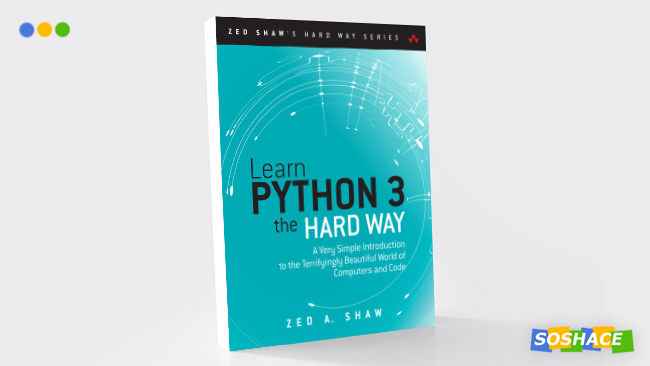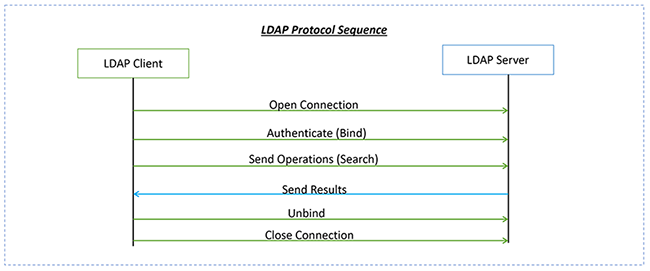
By the pace of development, the number of fans and job openings, Python has been growing at an impressive pace all the way through 2019 and keeps going strong this year as well. Assuming that the language can reach and surpass the user base of Java in the next 2-3 years wouldn’t be too bold at this rate. Why is Python so big right now? What does it mean for business owners and software developers? In this post, we will take a closer look at the phenomenon of the language, its benefits, future, and skills needed to rival outstanding Python coders.
Python: Software Development Sensation of the Decade
Even if you don’t track software development trends actively, it doesn’t take a genius to pick up on the outstanding growth of Python. Here are the most telling statistics that illustrate how big the market for the programming language is:
- Ranked first in the Programming Language Popularity Index. This list of top programming languages is based on the number of times tutorials are searched on Google. The number of programmers eager to learn Python can’t compare with that of other languages – all thanks to a straightforward syntax and a wide range of learning tools.
- Ranked third in the TIOBE Index. Here, only C and Java got higher than Python – even that seems to be a matter of time (this year, Python’s market share beat its 8.37% high).
- Stack Overflow Trends show that Python has the most dynamic growth among programming languages, leaving Java, JS, C++, C#, and PHP far behind. The platform’s founders estimate that, by the end of 2020, Python will become the most popular Stack Overflow tag.
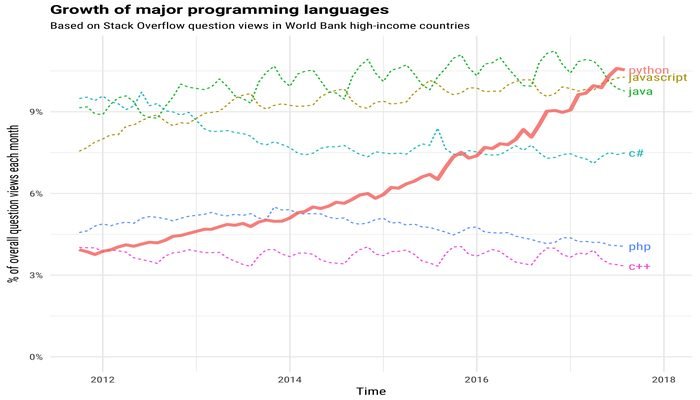
- According to GitHub, Python is the most popular AI and machine learning language.
Python: Job Openings and Salaries
Considering the growing popularity of Python, entry-level software developers might be overwhelmed by job market competition. Seeing the huge number of coders that start their software development journeys by learning the language, wondering whether there’s room for another professional in such a saturated field is understandable.
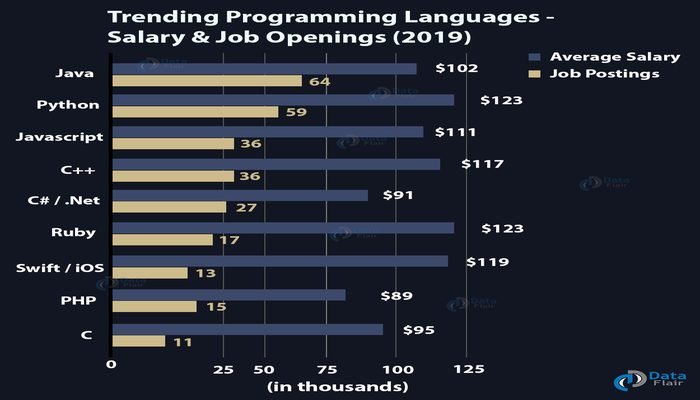
The good news is – Python developers will likely not be running out of jobs anytime soon. Indeed, there are over 24,900 available job openings in Python developments. Other than making a living as a Python programmer, you can apply the language as a machine learning tool and look for employment opportunities in that field. Indeed, there are over 25,400 ML openings, most of which require Python proficiency.
As for the python coders salary, skilled developers are definitely not at the bottom of the food chain. Here’s how much you can make according to PayScale:
- Entry-level Python developer – $51,000/yr
- Middle-level Python developer – $79,000/yr
- Senior Python developer – $107,000/yr
Behind the Curtains of Python’s Rise to Fame
Once you study statistics and realize how impressive Python’s growth rate is, a question begs for itself – how come the language gained such a following? To have a better idea of why developers love Python so much, take a look at its undeniable advantages:
1. Versatility
Python is attractive both to developers and business owners because there’s no set-in-stone use case for the language. Unlike R or PHP, you can’t describe Python as a web development or data processing-only language. According to developers’ survey, these are the most popular applications for the technology:
- Data analysis (58%)
- Web development (52%)
- DevOps/System Administration (43%)
- Machine learning (38%)
- Web parser, scrapper, crawler programming (37%)
- Software testing (32%)
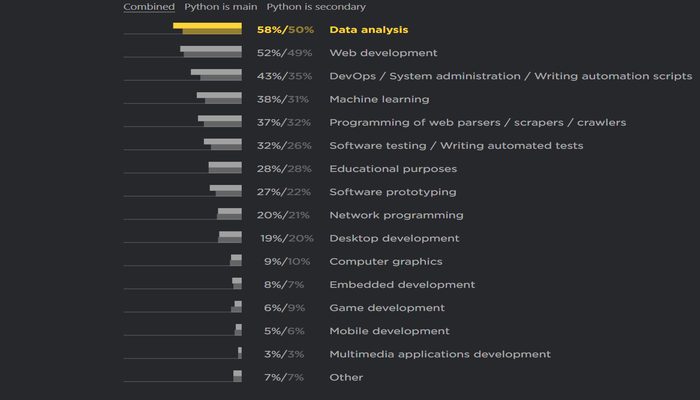
Python’s ecosystem has so many tools and applications that it’s up to you which one is more relevant, interesting, or ambitious.
2. Robust ecosystem
Tools like Django are another reason why Python becomes the developers’ love at first sight. The framework is highly convenient, helps create clean, readable code, facilitates and speeds up web development.
Other impressive Python-based tools are Wagtail – an intuitive CMS that helps create scalable, fast, and easy-to-maintain web pages, Pandas – data scientists’ go-to processing library, TensorFlow – a number-one prototyping system, OpenCV – a computer vision library, and many others.
Some other relevant Python frameworks are:
- Numpy – a Python library with a wide range of numerical computing tools. Developers use this one to operate matrices and multi-dimensional arrays.
- Scipy – a library used for scientific computing and technical projects – it supports linear algebra tools, signal processing, solving ODE tasks, and other typical scientific tasks.
- TensorFlow – a platform created by Google Brain to facilitate the task of machine learning models building.
- Keras – a Python API that facilitates neural network creation and operation. You can run it on Tensorflow, CNTK, or Theano.
- Matplotlib – an open-source Python framework that comprises Matlab-like features and facilitates data visualization.
- Pandas – a library used for data computation and analysis. It is used for data computation and analysis and is highly applied in data wrangling.
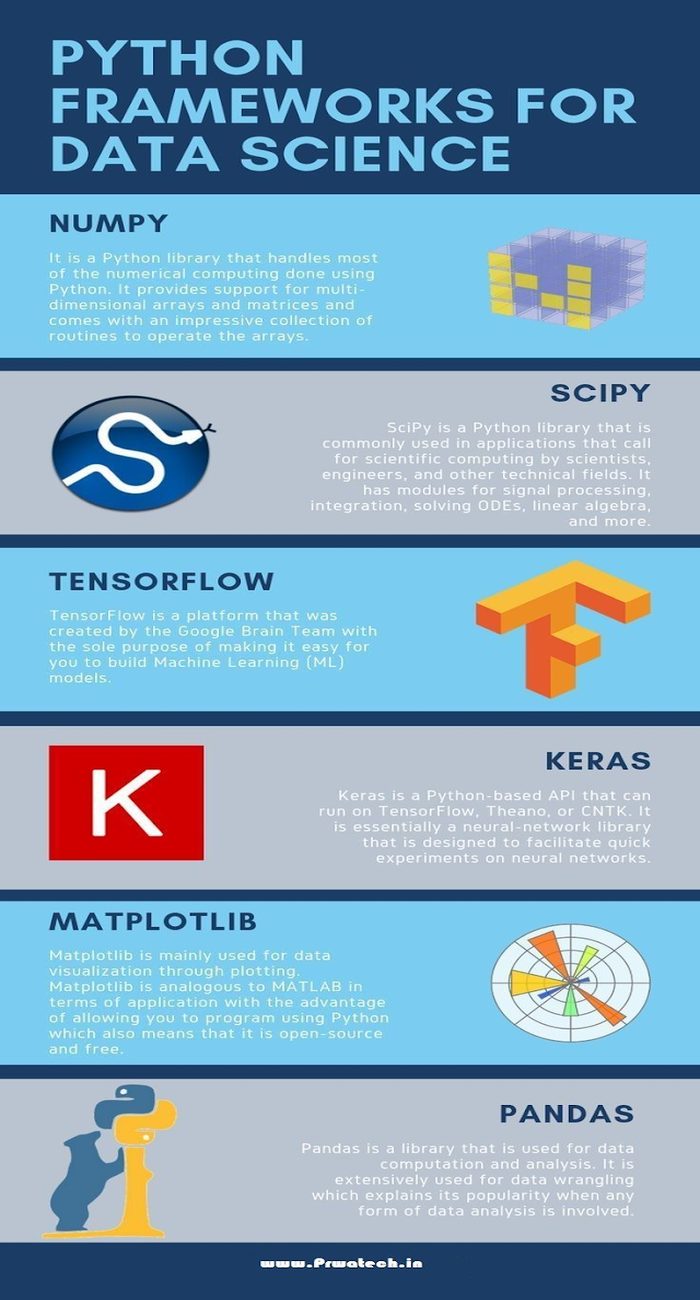
For software developers, Python is a full package – you will not need to create new tools on your own to speed up software development or use the language in a new way – all the building blocks are already at your disposal.
3. Software development community
Making Python a powerhouse that it has become is a long and challenging process – and it takes more than a single pair of hands to get there. The language has become so popular, accessible, and widely used thanks to enthusiastic developers who created learning materials, video tutorials, answered Stack Overflow questions, and shared code samples on GitHub.
In 2020, Python still has one of the most engaged developer communities. Here are some places where you can experience its full power:
- PySlackers on Slack
- Python thread on Stack Overflow
- r/Python community on Reddit
4. Easy to learn
Python is considered one of the best languages for software development newcomers to learn. Here’s why so many future engineers choose this one as their first programming course:
- You don’t need to know other programming languages to learn Python. The technology is standalone, meaning you will not have to connect your code to that in other languages to build functional applications from scratch.
- It has a simple syntax. If you had some experience with Java or C++, Python might feel illogical and chaotic at first. However, a few projects down the line, you will come to appreciate the simplicity the language offers – there’s less code, it’s more readable, and there aren’t as many exceptions as in languages like Java.
Take a look at how much more complex the syntax of C++ is compared to that of Python in the example below.
Creating a new variable in C++:
#include <iostream.h>
int main()
{
// If you have to declare one variable only
int a;
Creating a new variable in Python:
# A string name = "John"
Getting user input in C++
int main()
{
int a, b, c;
cout << "number one: ";
cin >> a;
cout << endl;
cout << "number two: ";
cin >> b;
cout << endl;
c = a + b;
cout << "Hello World" << endl;
cout << a << "+" << b << "=" << c;
return 0;
Getting user input in Python:
a = input("number one: ")
b = input("number two: ")
c = a + b
print("Hello World")
print(a, "+", b, "=", c)
- Python is dynamically typed – that means no need for typecasting or specifying variable type (both of these will get on a developer’s nerves eventually when working on a complex project).
- Python comes with powerful data structures that allow developers to think more about code implementation than about its structure.
7 Skills of a Top-Notch Python Developer
If you are an entry-level software developer eager to start learning Python and explore the opportunities it offers or a business owner who wants to make sure he hires a creme-de-la-creme developer to handle his new project, it’s helpful to know which skills define a professional in Python development.
According to statistics, 50-69% business managers of different scales expect developers working for them to have a bachelor degree, preferably a technical one.
As a rule of thumb, employers and computer science professors emphasize the importance of these 7 skills in Python programming:
- A solid understanding of the Object-Oriented Programming concepts since Python is an OOP language;
- Being skilled at using dictionaries – they are a go-to tool for most Python developers and facilitate data storage a great deal;
- Knowing how to handle packages – both import and deconstruct them
- Understanding looping clearly, knowing the difference between and the application of for, while, and if/else loops. Looping is extremely convenient since it allows developers to overuse the same block of code and cuts development time.
Here’s an example of a Python “while” loop syntax:
while expression: statement
For loops and nested loops are another crucial Python programming concepts software developers can’t afford to miss out on.
- Being well-versed in the aspects of the language dedicated to AI development (artificial neural networks, dynamic programming, natural language processing, etc).
- Debugging and unit testing – make sure you are comfortable using debugging tools your IDE offers, as well as developer tools for Chrome and Firefox.
- The ability to write elegant code that fully corresponds to the idiomatic nature of the language.
Conclusion
Although Python anti fans like to shame the language for being slow or easily accessible, the strong points of the language far outweigh its few drawbacks.
The range of Python’s applications is constantly increasing, thanks to thousands of new packages that are launched every day – as for now, there are over 200,000 items available in the library.
Tools like Keras made Python an instant favorite for AI developers, although the potential of the language reaches far beyond. The language is a go-to choice for scientists and statisticians, application developers, and web devs who handle scripting tasks.
As an entry-level developer, you need to determine which application of the language is the most important one for you and focus on mastering the toolkit available in the field. This way, you will not learn redundant or outdated concepts and will be able to match the power of Python directly to your coding needs.




